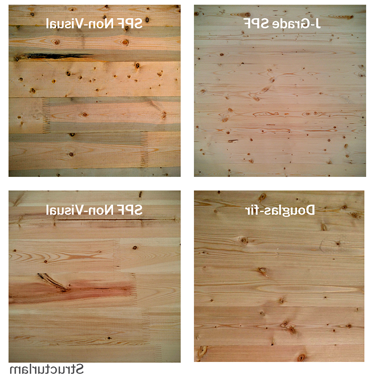专家建议
Specifying Appearance for CLT, NLT and Glulam
为寻求指定交叉层压木材(CLT)外观的设计师提供的信息, nail-laminated timber (NLT), or glue-laminated timber (glulam).

For mass timber, specification of appearance varies by product. 交叉层压木材(CLT)和钉层压木材(NLT)的美学期望由建筑设计师和制造商/制造商商定,并在产品规范中进行描述, whereas for glued-laminated timber (glulam) are standardized. 历史上,外观分类也被称为“外观等级”.“然而, 由于可能与结构等级混淆,该行业正在逐渐放弃这个术语.
此时的外表
Starting with the 2015 version of the International Building Code (IBC), 按规定,在允许使用重型/大质量木材的建筑类型中,CLT是允许使用的,只要它是按照 ANSI/APA PRG 320 Standard for Performance-Rated Cross-laminated Timber (IBC 2303.1.4). 第七节.PRG 320第3条规定:“CLT面板外观应由最终用户和CLT制造商商定.“PRG 320附录十一列出建筑和工业外观的方案如下:
附录ξ. EXAMPLES OF CLT APPEARANCE CLASSIFICATIONS (NON-MANDATORY)
本附录包含用木材层压制造的CLT板的CLT外观分类示例,仅供参考. 的se requirements are based on the appearance at the time of manufacturing. 建议最终用户和CLT制造商就实际的CLT面板外观要求达成一致.
- X1-1 建筑 Appearance Classification
一种外观分类,通常适用于外观很重要的应用场合, but not overriding consideration. Specific characteristics of this classification are as follows:
- In exposed surfaces, all knot holes and voids measuring over 3/4 in. (19毫米)填充木色调填充物或选择与相邻木材的纹理和颜色相似的透明木材插入物.
- 暴露在视野中的面部层没有松散的结,开放的结孔被填充.
- Knot holes do not exceed 3/4 in. 当在层压长度方向测量时(19mm),但空隙可能长于3/4英寸. (19 mm) if its area is not greater than 1/2 in. (323 mm).
- Voids greater than 1/16 in. (1.6毫米)宽,由出现在暴露于视图的表面层上的边缘接缝创建.
- Exposed surfaces are surfaced smooth with no misses permitted.
2. X1-2. 工业 Appearance Classification
- Voids appearing on the edges of laminations need not be filled.
- 松散的结和结孔出现在面层暴露在视野不填补.
- 构件仅在表面层上表面,外观要求仅适用于这些层.
- Occasional misses, 表层允许薄层或薄层(限于木材等级),长度不受限制.
大多数北美制造商和建筑设计师要么遵循附录十一中的指导方针, 或在工程规格书中加入一节,定义“未暴露”和“暴露”的外观,并说明每一种(e)的可接受参数.g. checking, knot size, color variation, etc.). 一些CLT制造商提供文件,概述了他们生产的产品的外观选择.
In Europe, terms such as WSI, ISI and NSI also relate to CLT appearance. However, they are rarely if ever used by North American manufacturers.
DLT and NLT Appearance
Since DLT and NLT do not have a recognized standard for production, 由设计团队(通常是建筑师)来注意面板的外观和质量要求. 与CLT一样,这些信息通常包含在项目规范中.
用于DLT和NLT的原材料(通常是2倍的框架木材)在IBC中是标准化的, 美国木材委员会的国家木结构设计规范(NDS), 以及美国木材标准委员会的自愿产品标准20,所以这些来源的语言可以是一个有用的起点. 的 U.S. Nail-Laminated Timber Design & Construction Guide also includes discussion of appearance options. 例如,它注意到可以指定以下表面特性:
- 物种
- 木材等级
- Eased or sharp edges
- Cross section size
参见第2节.1.2 of the NLT Guide for additional information and panel examples, 哪些有助于建立可接受和不可接受的审美特征. Appearance charts can be found in Appendix A.
Glulam Appearance 分类
Glulam is manufactured to various appearance classifications—including Premium, 建筑, 工业 and Framing—for structural and architectural applications. 这些分类区分了在胶合木表面可见的各种自然生长水平和制造特征. 的y do not characterize or affect structural performance.
Of these classifications, Premium和建筑通常用于构件可能暴露并且可能需要整理的应用中. Premium is usually specified where appearance is the primary design consideration; however, it is usually a custom order. 体系结构分类适用于外观很重要但不是主要考虑因素的应用程序. Several sub-categories, including Framing-L and 工业-L are also available. 这些与它们的主要外观分类相匹配,除了最外层的层是层压单板木材(LVL)而不是尺寸木材. 有关外观分类的其他信息可在 ANSI A190.1-2022 木制品美国国家标准:结构胶合层压木材.
Glulam is also available with either a smooth or a rough textured surface. 粗糙的纹理表面可能需要比光滑表面多一倍的抛光.
For additional resources see the technical note: Glulam Appearance 分类 for Construction Applications 从美国心理学协会.
我们的 制造商 & Supplier Directory is a great place to find and connect with wood product manufacturers. If you have any questions on specifying appearance grades for your project, email the WoodWorks Project Assistance Help Desk at help@4499ku.com



